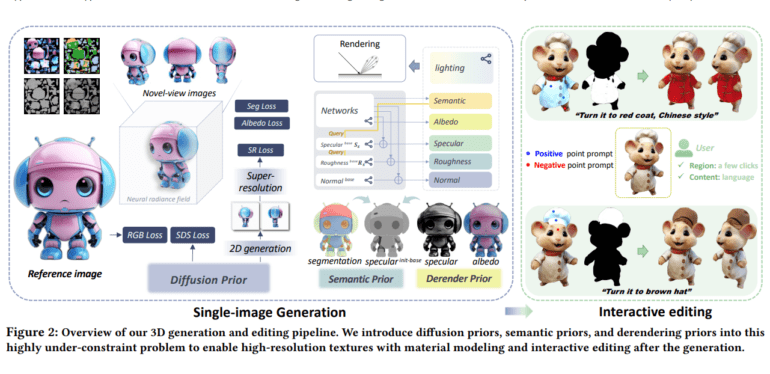TL;DR:
- HyperDreamer, a revolutionary framework, enables the creation of detailed and realistic 3D content directly from a single 2D image.
- The research explores the evolution of text-guided 3D generation methods, highlighting notable works and advanced techniques.
- Conventional 3D content generation approaches face limitations, particularly in post-generation usability and biases.
- HyperDreamer addresses these limitations through a custom super-resolution module, semantic-aware albedo regularization, and interactive editing.
- Deep priors, semantic segmentation, and material estimation models play a pivotal role in enabling HyperDreamer’s success.
- HyperDreamer sets a new standard in 3D content creation, offering high-quality, editable, and realistic 3D content from single RGB images.
Main AI News:
In the fast-paced world of business and technology, staying ahead of the curve is paramount. Innovation often stems from addressing challenging problems, and the realm of 3D content creation is no exception. The ambitious minds at Shanghai AI Laboratory, The Chinese University of Hong Kong, Shanghai Jiao Tong University, and S-Lab NTU have unveiled a groundbreaking solution: HyperDreamer. This cutting-edge framework is set to redefine 3D content creation with its advanced texturing, 360-degree modeling, and interactive editing capabilities.
Creating intricate and lifelike 3D models from a single RGB image has long been a formidable task. HyperDreamer, however, rises to the occasion by empowering creators to craft 3D content that is not only viewable and renderable but also editable directly from a 2D image. This innovation represents a paradigm shift in the world of 3D content generation.
Evolving the Landscape: A Look at Text-Guided 3D Generation
HyperDreamer’s arrival marks a pivotal moment in the evolution of text-guided 3D generation methods. The study, penned by the brilliant minds behind this framework, sheds light on the journey thus far. It references notable works like Dream Fields, DreamFusion, Magic3D, and Fantasia3D, all of which have pushed the boundaries of 3D content creation. These approaches employ cutting-edge techniques such as CLIP, diffusion models, and spatially varying BRDF.
Furthermore, the research highlights single-image reconstruction methods, encompassing both inference-based and optimization-based strategies that leverage priors from text-to-image diffusion models. These innovative approaches have taken us closer to achieving realism in 3D content generation, but challenges remain.
The Need for HyperDreamer: Overcoming Limitations
As the demand for advanced 3D content generation continues to grow, conventional methods face limitations. Recent 2D diffusion-based techniques, while promising, grapple with issues related to post-generation usability and biases. In response, HyperDreamer emerges as a comprehensive solution, empowering the creation of 3D content that is both visually stunning and highly editable from a single RGB image.
HyperDreamer brings together a suite of technologies to achieve remarkable results. It incorporates a custom super-resolution module, semantic-aware albedo regularization, and interactive editing features. These components collectively address the challenges of realism, rendering quality, and post-generation editing capabilities, setting a new standard in 3D content creation.
The Power of Deep Priors and Interactive Editing
At the core of HyperDreamer’s success are its deep priors derived from 2D diffusion, semantic segmentation, and material estimation models. These priors enable the generation of comprehensive 3D content and ensure high-fidelity texture creation. Material modeling, facilitated by online 3D semantic segmentation and semantic-aware regularizations, further enhances the realism of the generated content.
HyperDreamer’s revolutionary approach extends to interactive editing, allowing effortless targeted modifications on 3D meshes via interactive segmentation. This feature not only enhances the creative potential of the framework but also showcases its robustness, outperforming traditional segmentation methods.
HyperDreamer: Where Realism Meets Innovation
In summary, HyperDreamer represents a significant leap forward in the world of 3D content creation. With its ability to generate realistic and high-quality 3D content from a single RGB image, it offers unparalleled viewability, renderability, and editability. Comparative evaluations have underscored its superiority over optimization-based methods, producing lifelike and rational creations from various angles. The super-resolution module unlocks intricate texture details, enabling high-resolution zoom-ins that were once unimaginable. The integration of deep priors, semantic segmentation, and material estimation models cements HyperDreamer’s position as a pioneer in the generation of hyper-realistic 3D content from a single image.
Conclusion:
HyperDreamer’s emergence as a game-changing solution in 3D content creation is poised to transform the market. Businesses seeking innovative ways to engage audiences and enhance products will benefit immensely from this framework. HyperDreamer’s ability to produce high-quality, editable, and realistic 3D content from single images will open up new creative avenues and set a new benchmark in the industry. The future of 3D content creation is more promising than ever, thanks to HyperDreamer’s groundbreaking capabilities.

